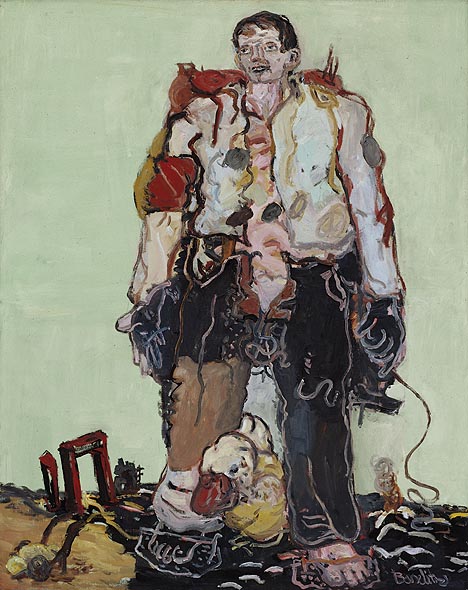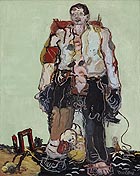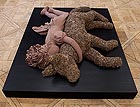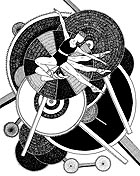
translated and summarized by: Liz Wollner-Grandville,
English summary February 8 - 13
Museum Frieder Burda: Baselitz. A Retrospective
Aging of the wild ones
Polke was already here, Richter as well, now it’s Baselitz. Again, it was Götz Adriani who presented one of the great masters of German art at the Museum Frieder Burda. “50 years of painting”, as the title already states, are presented here. Next door, in the 100-year older Kunsthalle Baden-Baden, director and curator Karola Kraus devoted the exhibition “30 Years of Sculpture” to Baselitz’s sculptural works. This is the first co-production of the two institutions, but obviously they did not really team up. Apart from the medium, the two presentations could not be more diverse.
While Toni Stoos’s Baselitz-retrospective at the Salzburg Museum of Modern Art last summer at least attempted to show “what comes from where, and how has it changed”, it remains unclear on which idea or order the exhibition at the Frieder Burda is based. Wandering through the exhibit lets one wonder about the arbitrary arrangement of the large-format paintings.
Only the works displayed on the top floor are somewhat compensatory. A clear thesis or a strict chronology would have done the presentation of Georg Baselitz’s works well. After all, the radical breaks in his works evoke interest, and, as he describes them - they are based on the principle of disharmony, unbalance and destruction.
The exhibit at the neighbouring Kunsthalle is more rigid. In each room one sculpture is juxtaposed according to formal aspects with one painting. This might be perceived as extremely arthistoric, but the encounters are all definitely fascinating. And Karola Kraus refrained from publishing yet another catalogue and instead edited the catalogue raisonné of sculptures. Great performance, great achievement.
By Daniela Gregori
Museum Frieder Burda
76530 Baden-Baden, Lichtentaler Allee 8b, until 14.03.10
http://www.sammlung-frieder-burda.de" target="_blank">www.sammlung-frieder-burda.de
Exhibition at the Staatliche Kunsthalle Baden-Baden
Baselitz. 30 Years of Sculpture
Lichtentaler Allee 8A
76430 Baden-Baden, until 14.03.10
www.kunsthalle-baden-baden.de
Kunsthalle Wien: Tropicália – The 60’s in Brazil
Defiant Tropics
The parrot cages in Hélio Oiticicas installation “Tropicália”, after which the collection of Brazilian art of the 1960’s is named, are arranged according to “species-appropriate husbandry”. A signboard with information about the collection and the co-operation with the “Parrot Protection Work Group” are placed in the middle of the installation consisting among other things of sand, pebbles, cages, and post-minimalistic favela huts by the Brazilian conceptualist. In October 2009, a fire destroyed almost the entire archive of Oiticica’s work. It is therefore a fine idea that the Kunsthalle is also presenting two early constructivist works by the late Oiticicas, who died young in 1980.
In 1964, Brazil was already governed by a military dictatorship, long before the Juntas and generals prevailed in most other Latin American countries. Fine arts, literature, film, and Pop became the media of disapproval. And, to the best of their knowledge and belief, they undertook “interventions in ideological circuits”, similar to the inconspicuous writing on Cildo Meirele’s famous Coca Cola bottles. But is there such as thing as a “species appropriate husbandry” for art that evolved from protests by social movements? And, which, as the art historian Sabeth Buchmann stated in her report on conceptualism “Thoughts against Thinking” (Berlin 2007) about Oiticica, aimed at a modernist critical “connection of technology and idleness” against the capitalistic regime and which also claimed to represent pure life in one way or another? It is a structural problem of the artistic field.
Lygia Pape’s bowls filled with colourful liquids and arranged in a circle definitely do not aim at initiating a spiritual experience, and the documentation of Artur Barrio’s performances, who filled cloths with bloody meat and displayed them in public spaces, somehow lacks social context and odour. Adorno is correct when he commented that the phonetic similarity between museum and mausoleum is not coincidental. But the curator Thomas Mießgang is not responsible. After all, a few effects referring to the movement of the modernist poet Oswald de Andrade are presented: Rivane Neuenschwander’s “Epilogue” (2006) fits perfectly: in the end, the ants carry the confetti away one by one.
By Jens Kastner
Kunsthalle Wien
1070 Vienna, Museumsplatz 1, until 02.05.10
www.kunsthallewien.at
Galerie nächst St. Stephan: Aneta Grzeszykowska, Elisabeth Penker
Tracking social classification systems
The two exhibitions, one by Aneta Grzeszykowska in the gallery rooms and the other by Elisabeth Penker in the project room “LOGIN” couldn’t be more diverse. The only instance in which they correlate results from both artists dealing with system developments and agglomerations based on meanings attributed to society. While Aneta Grzeszykoska’s view, who lives in Warsaw, is defined by psychologically and culture, that of Elisabeth Penker, who lives in Vienna and Rome, can be described as ethnographic and linguistic. Through their juxtaposition they form sharp contrasts.
Aneta Grzeszykowska focuses on private life in diverse visual translations. In a photo series, created together with the Warsaw-based artist Jan Smaga, she mapped apartments from a bird’s eye view to narrate an intimate story of the city and the arrangement of rooms, furniture, and everyday utilities. In the film “Birthday” she relives early childhood memories of creepy situations. It was filmed in the style of a private documentation on one’s own child’s birthday party. With commenting interventions such as the animation of otherwise immovable objects the artist criticizes conventions and thereby underlines the monstrosity of such events. She integrates a series of monochrome dark cloth figurines in the ambiguity of staging her childhood with the abysmal. The figurines are dressed like the artist when she was a child, and attempt to treat dramatic situations in an aesthetically formalized way. Such as, for example, a photograph of her brother’s injured eye, for which she was accidentally responsible or a fairytale-like relief sculpture with a girl on a dog made of thorny thistles.
Penker’s exhibition “LOGIN” undertakes deep drillings into the core of semantic systems. The artist and musician Penker is well known for her intervention in the arcades of the University of Vienna with a bust of the Austrian Romanist and first female university professor, Elise Richter. Richter headed the Institute of Phonetics until the Nazis deported her to Theresienstadt, and was - as the accomplishments of women in general - a non-issue among the patriarchal arrangement of stone figurines displayed in the university hallways and arcades.
Her approaches are always directed towards generating meaning in the sense of grammars. Accordingly, the portrait of the recently deceased ethnologist Claude Lévi-Strauss functions as a key motif in the installation together with an integrated sound composition. Lévi-Strauss’s mirrored and spread-out photograph in “polysynthetic double perspective” can be interpreted as an intersection of linguistic, tonal, and visual aspects.
Square-shaped wood was painted in exactly the same colour as the sediments superimposed on one another and uncovered beneath the wall painting. The oblong pieces of wood refer to the linguistic derivation of “log”, which is a tree trunk (German: Baumstamm) and thereby to the title of the gallery’s exhibition series. It is somewhat remarkable that a word consisting of only one morpheme represents an object. A fundamental network of references is constructed through a series of other objects such as for example the “Hanging Chairs”. With her works and abstract sound compositions, Penker pushes her way into the macro-areas of grammars and exposes the potential of semantic connections in neighbouring systems.
By Roland Schöny
Galerie nächst St. Stephan
1010 Vienna, Grünangergasse 1 / 2, until 06.03.10
www.schwarzwaelder.at
artlounge Strabag Kunstforum: Moussa Kone – en pointe (switch legs, left up, around, and reach)
Sign language
In the artlounge Strabag exhibition, the artist, known for his multipart large-format drawings and installations, presents small, almost constructivist ink drawings with faceless ballet dancers as the central element of design. Moussa Kone’s works, born 1979, are as precise as usual, but just one iota clearer, more focussed, and more free - both in their delivery as well as the choice of the topic. And despite their remarkable diversity and exuberant fantasy these paintings never seem to be from another world. They are more like a distorting mirror of everyday (real) life, without drifting into the caricatural or illustrational. They do not narrate, but nevertheless they talk to us, they captivate, but one will never lose oneself in them, as they masterfully hold the balance – similar to an expert dancer, between identification and critical distance.
It seems incredible that, despite the large number of works displayed, there is not a single poor piece among them. Visiting this exhibition is an imperative and an ideal opportunity to become acquainted with absolutely unique art.
By Wolfgang Pichler
artlounge Strabag Kunstforum
1220 Vienna, Donau-City-Strasse 9, until 05.03.10
www.strabag-kunstforum.at
Mehr Texte von translated and summarized by: Liz Wollner-Grandville


 Teilen
Teilen






